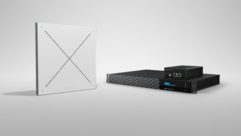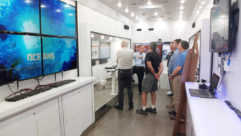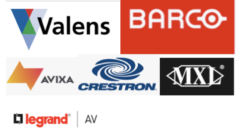
Array, or not to array? That is the Question, Part 2
May 11, 2012 11:08 AM,
By Bob McCarthy
Understanding coverage stretching and pattern bending.

Figure 1: Uncoupled array spacing example. (a) 60° speaker has a 1:1 ratio of length to width. Therefore, 10-foot spacing yields even coverage at a 10-foot distance. (b) The speaker is changed to a 90° model, which has a ratio of 1.4:1, so the coverage moves closer to 7ft. (c) 90° model is moved out to a 14-foot spacing and we return to even coverage at 10ft. yields even coverage at a 10-foot distance. See larger image
In part 1, we discussed the coverage shape of a single speaker and how we could use multiple speakers to create a similar shape. We demonstrated that a point source array can mimic our example 80-degree speaker by slicing up the coverage into segments of various sizes (from 2×40 degrees to 40×2 degrees). In this second part, we will move forward by using multiple speakers to create shapes that no single speaker can possibly create. The two avenues we will explore are pattern stretching and pattern bending. In both cases, as you will see, the traditional thinking of coverage angle will give way to visualizing coverage shape.
Coverage stretching: uncoupled arrays
When speakers are placed close together (coupled), there are three possible outcomes: the combined response will be wider, narrower, or the same as the individual elements. The decisive factor is the percentage of angular overlap. If the overlap is low, the combined pattern is wider than the single element. If the overlap is high, the responses converge in the middle and narrow the pattern. If the two forces are equal (overlap of 50 percent) then a stalemate results.
When speakers are moved significantly apart (uncoupled), the result is almost sure to be a widening of the pattern. Essentially, there are two array tools for widening the response: angular isolation and level isolation. Coupled arrays use the former and uncoupled arrays can use both; the level isolation comes from the physical separation and the angular can be added to that. If we can widen the response with either type of array, then what would be the reason to choose coupled or uncoupled?

Figure 2: Coupled array example. The goal is to create a 60° array (+10°, -50° coverage) with 6dB of level asymmetry. (a) Symmetric array with 3×20° elements splayed at 20°. (b) 3×20° elements with asymmetric splay angles of 10° and 40°. Note the gap between the second and third elements. (c) 3×20° elements splayed at 20° with asymmetric levels. The lower sections are -3dB and -6dB, respectively. Note the lossy areas around the transitions. (d) 3×20° elements splayed at 14° with -3dB and -6dB level taper. Seamless transition, but the coverage is only 48°. (e) 4×20° elements at 15° with -2 dB, -4dB, and -6dB level asymmetry. This creates seamless 60° coverage with 6dB of level asymmetry. See larger image
A coupled array can be spread to a maximum of 360 degrees, after which it is chasing its tail. An uncoupled array can spread an unlimited distance, such as from Hollywood to San Francisco, (e.g., the parade route at Disney’s California Adventures park). So if your audience is spread out sideways on a line, there is not a suitable angular solution. Additional examples of this type of application include frontfill arrays, underbalcony delays, and racetracks. In such cases we don’t think of the coverage in angular terms. Instead we might think of the target as three rows deep and 40 seats wide. In order to move the mind toward thinking about uncoupled array shaping we have to reset our thinking about speaker coverage from the traditional “slice of pizza” angular thinking into length and width. In other words, how wide is my coverage at a given distance?
Let’s start with a 60-degree speaker. At a distance of 10ft., it has a coverage of 10ft.—5ft. either side of center. This is a 1:1 relationship between length and width. If you want to extend a line of 60-degree devices and obtain even coverage, the spacing between the boxes should be the same as the distance to the start of coverage. If your first row is 10ft. from the stage lip, the 60-degree frontfills will need to be spaced at 10ft. intervals. This is shown in Figure 1a. If the speaker is narrower than 60 degrees, the spacing (for a given start distance) will be smaller. The opposite is true for wider devices. For example, a 90-degree speaker has a ratio of 1.4:1. If we kept the same spacing, the gap would close at 7ft. instead of the 10ft. (shown in Figure 1b). Alternatively we could use a 14ft. spacing to keep the start of coverage at 10ft. (shown in Figure 1c). Things get more interesting, however, when we combine splay angle and distance. If the speakers are splayed out, then they must be spaced closer together to achieve the same combination start point. A calculation program that tells you the proper spacing for any given speaker coverage and splay is available through my blog at www.bobmcarthy.wordpress.com.
Coverage bending: coupled arrays
In part 1 we mimicked a symmetric speaker with point source arrays of various types. Now we will use the coupled point source to create a family of asymmetric shapes of approximately 60 degrees. It is easy to define a symmetric speaker coverage shape: the coverage area (between the -6dB points) is a radial section of a circle. A coupled point source has a natural tendency toward the symmetric radial shape. How can we bend the point source to create an asymmetric shape? This will require either asymmetry in the speaker models, levels, and/or splay angles. But before we start steering the speakers, we need to define the target.
The two keys that define an asymmetric coverage target are the angular spread and the range (distance) ratio. The angular spread is found just as it was in the symmetric array. The range ratio is the difference between the farthest area of coverage and the closest. This is easiest to visualize with a flown system in the vertical plane, where the listeners in the rear are farther from the speakers than the folks in front. Here’s a simple example: The last row is 100ft. away and 10 degrees above the cluster, while the closest seats are 50ft. away and 50 degrees under. The ratio is 2:1, a difference of 6dB in terms of sound level. The angular coverage spread is 60 degrees (from +10 degrees to -50 degrees). So now we have a defined target shape: 60 degrees of coverage with 6dB of asymmetry (2:1). The array will need to be shaped to throw 6dB more energy to the far seats in order to equalize the levels from front to back.
Let’s change the cluster position. If we brought the cluster down lower, we might find ourselves just 25ft. from the front seats, but still around 100ft. to the rear. Now the range ratio has increased to 4:1 (12dB), and we will require a much stronger shaping to overcome the radial tendency of the array. An additional consideration is that the new position will most likely reduce the angular spread. Our 60-degree spread, 2:1 (6dB) level asymmetry original cluster may need to change over to a 45-degree spread with a 4:1 (12dB) range ratio. Conversely, if we were to move the speaker higher, we will find the angular spread increasing and the range ratio decreasing.
Array, or not to array? That is the Question, Part 2
May 11, 2012 11:08 AM,
By Bob McCarthy
Understanding coverage stretching and pattern bending.

Figure 3: Coupled array with 10°, 20°, and 30° elements. The result is seamless 60° coverage with 6dB of level asymmetry. See larger image.
How is the asymmetric steering done? There are several options. We can use asymmetric speaker elements in a symmetric array. This is difficult because 99 percent of the speakers on the market are highly symmetrical, and the few asymmetric ones out there might not have the same shape as we desire. The next and more standard options include using unmatched speakers, e.g., creating a 60-degree array from a combination of 10-degree, 20-degree, and 30-degree elements. The most popular method currently is to use a matched set of symmetric elements and enact asymmetric splay angle and level strategies, e.g., 15 elements all splayed at 4-degree combine to make a symmetric 60-degree speaker (range ratio equal 0dB). The same 15 elements can create an asymmetric 60-degree response by narrowing the splay angles of the upper elements and widening the splay of the lower ones. A similar shaping can be implemented by reducing the level of the lower boxes. We can increase the steering even more by combining both splay angle and level tapering.

Figure 4: Coupled array comprised of 15 speakers with a 10° individual coverage (a) 15 elements at 4° make a symmetric 60° array. (b) Two-segment array with 7×3°(21°) and 8×5° (40°). Result is 60° of coverage, but only 2dB of level asymmetry. (c) Three-segment array with 5×2° (10°), 5×4° (20°), and 5×6°(30°). Result is 60° of coverage with 6dB of level asymmetry. (d) Three-segment array with 6×2° (12°), 6×4° (24°), and 3×8°(24°). Result is 60° of coverage with 8dB of level asymmetry. See larger image.
Let’s let the 60-degree coverage with 6dB of level asymmetry target serve as our example. We will start with a symmetric array of 3×20-degree speakers splayed at 20 degrees (shown in Figure 2a). Since the speakers are matched, we have only the options of splay angle and level tapering. We could reduce the splay between the top two boxes, which will cause the level to increase in their overlap area. Let’s try 10 degrees. So far, so good. We still need 60 degrees total, so we will need to make up the lost 10 degrees by increasing the lower splay to 40 degrees. Now we have a problem (Figure 2b), a 10-degree gap inside the array. We can’t open the splay between the lower boxes beyond 20 degrees since this will cause a gap in coverage. If we close the gap, we have a different problem: We have only 50 degrees of coverage. This approach won’t work unless we have more speakers.
The second option with the 3×20-degree speakers is to leave both splays at 20 degrees and taper the levels of the lower two speakers by 3dB and 6dB as shown in Figure 2c. Sounds straightforward enough, but there is a twist: This won’t work well because the transitions between the speakers will not be combinations of the -6dB points but rather a -6dB and -9dB element (since one is turned down 3dB). In order to prevent soft spots in the coverage, we will need to reduce the splay angle to 70 percent of the normal angle (since -3dB is 70 percent of 0dB). Now we have a splay angle of 14 degrees and once again we don’t have our full 60 degrees of coverage. Instead we would have around 48 degrees (10+14+14+10). This is shown in Figure 2d, which shows a seamless transition between the speaker elements.
The lesson here is that is if we taper angle or level we will lose coverage, which will need to be made up by either having wider elements, or more of them. We could cover our target shape with either 3×28-degree speakers (splayed at 20 degrees and tapered in 3dB steps) or 4×20-degree speakers (splayed at 15 degrees and tapered in 2dB steps), as shown in Figure 2e.
It is easy to visualize that three different speakers: 10-degree, 20-degree, and 30-degree elements would combine to create a shape that extends further forward in the upper section. The reason is that the 10-degree horn concentrates its energy into a far smaller area than the 30-degree element. If we were to consider the center unit, the 20-degree speaker as the nominal level, then we can see that the upper speaker would be narrower and throw further, while the lower element would spread the energy over a wider area. For our example, we will consider the level asymmetry to have been handled by the difference between the elements. The coverage is divided into three sections, with the farthest area being the smallest angular area and vice versa. Now we can achieve our goal (60 degrees, 2:1 ratio) with three elements. This is shown in Figure 3.

Figure 5: A three-segment, 15-speaker coupled array with level tapering of -1.5dB and -3dB, respectively. (a) The same array in Figure 4c now achieves >8dB of level steering. (b) The same array as in Figure 4d achieves >10dB of level steering. See larger image.
If we want 60 degrees, but with a higher range ratio, we can reallocate the distribution of the angular load. Switching to 9-degree+18-degree+36-degree elements would extend the range slightly, while 15-degree+20-degree+ 25-degree would reduce it.
In order to ensure a smooth transition between elements, it is good practice not to make the angular changes too abrupt (1:2 ratio or less). Therefore a 60-degree array with 2 degrees+8 degrees+50 degrees would not be recommended, whereas the previous three examples would do fine. As the need for level asymmetry increases, we are likely to find it increasingly challenging to keep the transitions smooth. The answer is to increase the number of elements and further subdivide the angular load.
If we are concerned with a smooth transition, then the maximum asymmetry we can get out of two elements for our 60-degree array would be 20 degrees+40 degrees. If we expand to three elements, then we can use 8.5 degrees+17 degrees+34 degrees. With four elements, we can go to: 4 degrees+8 degrees+16 degrees+32 degrees. The difference between the narrow and wide speaker has now expanded to an 8:1 ratio, so we are really going to see some strong level asymmetry in the shape.
It is not easy to shop around for 4-degree, 8.5-degree, or 17-degree speakers. It would be much easier if we could just custom build array elements to the coverage angles we need. Good news, we can! Recall from the part 1 that we built symmetric 80-degree arrays from 16 elements at 5 degrees each. We could think of this as two 40-degree speakers (made of eight elements each), four 20-degree speakers (made of four elements each), or various other ways to slice it. Once we have broken the 16 boxes into segments, we can start to reallocate the elements to create different speakers, narrow ones for the long throw and wide ones for the short throw.
Returning to our 60-degree example, we can see that with 15 boxes we could fill the shape with all of the elements at 4 degrees. Now we have a symmetric 60-degree speaker (refer to Figure 4a). Let’s begin the shaping process by breaking it into two elements: 20 degrees+40 degrees. If we split the resources evenly, we will use seven boxes at 3 degrees (to make a 21-degree upper speaker) and eight boxes at 5 degrees (to make a 40-degree speaker). The elements are all identical, but the upper system has much higher percentage overlap and therefore combines for more power in the upper area. We have begun the shaping process. The difference between a 3-degree splay and a 5-splay is less than 2:1, so we cannot expect a large amount of reshaping, and we can see less than 3dB of asymmetry in Figure 4b.
Let’s break it into three parts (five boxes each) and see how far we can get. Box A will be a 10-degree speaker (five boxes at 2 degrees). Box B is 20 degrees (5×4 degrees) and Box C is 30 degrees (5×6 degrees). Now the top to bottom ratio is 3:1, which will provide a much stronger steering—in this case 6dB as shown in figure 4c. Another three-part version (Figure 4d) will maximize the three-segment steering at 8dB with 12-degree, 24-degree, and 24-degree sections (A=6×2 degrees, B=6×4 degrees, and C=3×8 degrees). In this case, we have a 4:1 ratio between the widest and narrowest section. As a trend, we can expect 3dB of steering each time we multiply the splay variable (2:1=3dB, 3:1=6dB, 4:1=9dB).
If we are facing large range ratios, we can break the array into smaller sections or we can add some level tapering to the mix (or both). Let’s try 3dB of level taper to the three-section arrays (0dB, -1.5dB, and -3dB). The results can be seen in Figure 5a and 5b, which show that we gain an additional 2+dB of steering compared to their untapered versions (Figs 4c and 4d, respectively).
This process can go on for as long as you have a budget. As the need for additional steering arises so will the box count. We used 15 boxes in our example, but if we have more elements, we can more easily break them into smaller sections and achieve vey high levels of asymmetry. As was the case in part 1, the data shown is only an excerpt of that required to more fully grasp this subject. Additional data can be found on my blog at www.bobmccarthy.wordpress.com.










